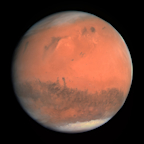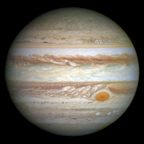Search results
Saturn is the sixth planet from the Sun and the second largest in the Solar System, after Jupiter.
Saturn is the sixth planet from the Sun and the second largest planet in our solar system. Adorned with a dazzling system of icy rings, Saturn is unique among the planets. Saturn is a massive ball made mostly of hydrogen and helium.
Sep 8, 2024 · Saturn, ringed planet that is the second largest planet in the solar system in mass and size and the sixth nearest planet in distance to the Sun. When viewed through even a small telescope, the planet encircled by its magnificent rings is arguably the most sublime object in the solar system.
Saturn has the second-shortest day in the solar system. One day on Saturn takes only 10.7 hours (the time it takes for Saturn to rotate or spin around once), and Saturn makes a complete orbit around the Sun (a year in Saturnian time) in about 29.4 Earth years (10,756 Earth days).
Saturn. Learn more about the sixth planet in our solar system and its rings. 5 min read. Saturn was the most distant of the five planets known to the ancients. In 1610, Italian astronomer...
Jun 8, 2023 · Saturn is the sixth planet from the Sun. That means Jupiter and Uranus are Saturn’s neighboring planets. Quick History. Saturn has been known since ancient times because it can be seen without advanced telescopes. Four robotic spacecraft have visited Saturn, including Pioneer 11, Cassini, and Voyager 1 and 2. What does Saturn look like?
Saturn is the sixth planet from the Sun and the second-largest planet in our solar system. Like fellow gas giant Jupiter, Saturn is a massive ball made mostly of hydrogen and helium. Saturn is not the only planet to have rings, but none are as spectacular or as complex as Saturn's. Saturn also has dozens of moons.
Sep 3, 2024 · Saturn is nearly 10 times farther from the sun than Earth and takes far longer to orbit the sun – about 29 Earth years. Saturn’s axis of rotation is tilted like Earth’s, and so it too has seasons, but the longer year produces seasons that last more than seven Earth years each.
May 26, 2004 · As Saturn grows closer through the eyes of the Cassini spacecraft, which is hurtling toward a rendezvous with the ringed world on June 30 (July 1, Universal Time), both Cassini and the Earth-orbiting Hubble Space Telescope snapped spectacular pictures of the planet and its magnificent rings.
Saturn: Exploration. Four robotic spacecraft have visited Saturn. NASA's Pioneer 11 provided the first close look in September 1979. NASA's twin Voyager 1 and Voyager 2 spacecraft followed up with flybys nine months apart in 1980 and 1981.



















